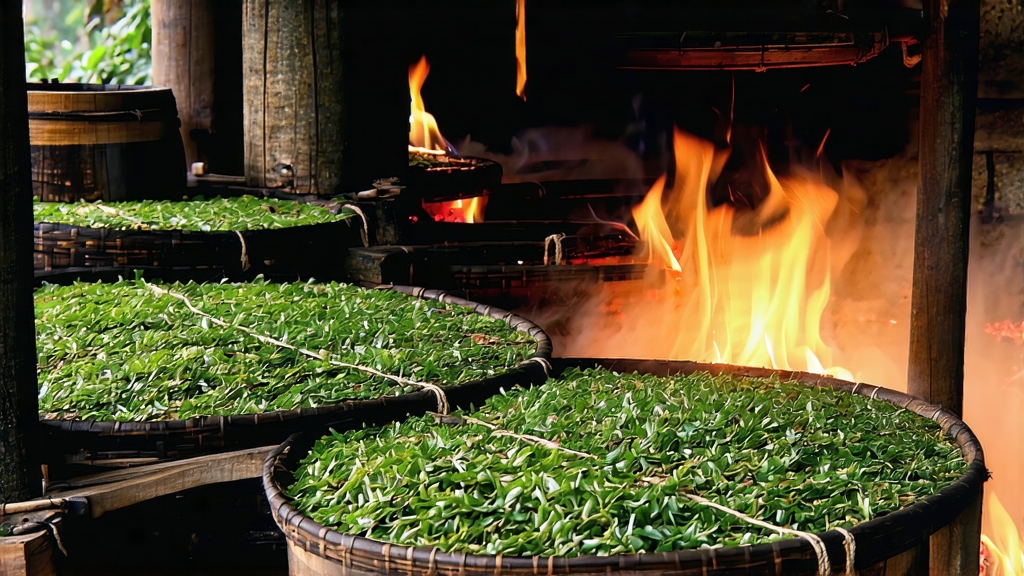
Long before English breakfast blends and Assam CTC filled millions of cups, a small village in the Wuyi massif of northern Fujian produced the very first black tea the world ever tasted. Locals still call it Zheng Shan Xiao Zhong—“small leaf from the original mountain”—but the global market knows it as Lapsang Souchong. Its story begins in the late Ming dynasty, around 1604, when passing Dutch traders noticed that the compressed green tea they expected had turned an ominous dark brown during the humid mountain trek. Rather than discard the cargo, they steeped it and discovered a malty, honeyed liquor unlike anything in Europe. By 1640 the Dutch East India Company was listing bohea (the Min-bei pronunciation of “Wuyi”) as a luxury item in Amsterdam auctions, and within two decades smoky Lapsang Souchong was perfuming the courts of Versailles and St. Petersburg. The tea thus predates—and in fact inspired—the black-tea industries of India, Sri Lanka and Kenya.
Geography is the first secret. The original 600-square-kilometre core zone lies inside the Wuyi National Nature Reserve, a UNESCO mixed heritage site where Jurassic sandstone cliffs funnel clouds into a perpetual mist. Day-night temperature swings of 15 °C slow leaf growth, concentrating amino acids and volatile aromatics. The indigenous cultivar is a petite, slightly twisted leaf group dubbed “cai cha” or vegetable tea, genetically distinct from the larger-leaf Assamica varieties that later dominated tropical plantations. Because the reserve bans pesticides and synthetic fertilisers, the bushes absorb resinous volatiles from the surrounding Masson pine and cedar forest, laying the groundwork for the tea’s signature fragrance.
Two styles of Lapsang Souchong exist today, separated by smoking technique rather than leaf grade. The traditional craft, now protected under China’s Geographic Indication law, insists on two fuel sources only: resin-rich pine logs and the roots of old fir trees. The modern “unsmoked” version, marketed as Wild Lapsang or Wuyi Black, omits the pine phase and appeals to palates that prefer cocoa and dried-longan notes. Both, however, begin the same way. Picking occurs for only ten days each spring, when the standard is one bud plus two leaves just after the Qingming festival. The fragile shoots are carried in lightweight bamboo baskets lined with fresh tea leaves to prevent bruising, then laid out on bamboo trays in the second-floor loft of a three-hundred-year-old wooden tea factory above the Tongmu River.
Withering is conducted over three separate intervals. First comes sun-withering: trays are slid onto slate terraces for twenty minutes of gentle morning light, enough to evaporate surface moisture without locking the green character. Next, pine-smoke withering: the trays are transferred to racks suspended two metres above a firebox of smouldering pine logs whose temperature never exceeds 35 °C. For eight hours the leaves inhale cool, aromatic smoke while enzymatic oxidation begins. Finally, indoor withering in a high-ceilinged room where the windows are opened or closed every fifteen minutes to manipulate humidity; this “soft shaking” coaxes the leaf cells to release grassy aldehydes and replace them with floral lactones.
Rolling follows, but unlike the brutal maceration used for CTC teas, Lapsang demands a tender touch. A master roller, always a woman whose forearms bear the faint green tattoos of decades past, applies just seven kilograms of pressure per square centimetre for twelve minutes, turning the leaves clockwise, then counter-clockwise, until the cell-wall rupture rate reaches 68 %—the exact threshold that allows oxygen to meet polyphenol oxidase without liquefying the leaf. She then scoops the twisted ribbons into a rattan basket whose inner wall has been rubbed with fresh ginger to neutralise any residual rawness.
Oxidation is the pivotal act. The leaf is spread three centimetres deep on rectangular bamboo mats stacked inside pine-wood cupboards. Every thirty minutes the cupboard doors swing open, the leaf is fluffed, and the aroma is judged. When the grassy note vanishes and a ripe longan fragrance emerges—usually after four hours—the leaf has reached 80 % oxidation. At this moment the master inserts a long iron needle into the pile; if the emerging tip glows a dull mahogany rather than bright copper, the batch is ready